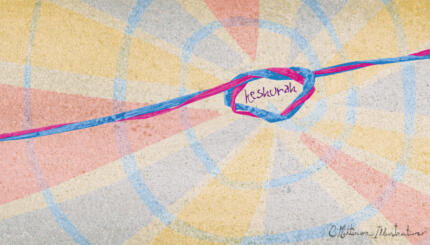Torah reflects the patriarchal society in which it was written. Reflects. You gotta love that mirror metaphor. No mirror is accurate; each reflects a particular distortion.
Learning to use any mirror takes time and patience. In fact, it took me years to recognize the contours of Torah’s mirror.
As a 20-year-old university student, I still saw life through a childish lens. One evening as I washed dishes, I reflected on how much I enjoy this chore. Warm water, playful soap bubbles. Why even when I was a child, I didn’t mind that my brother never had to wash dishes and only I…wait. Did I really do more household chores because I enjoyed them? Or because Mom assigned them all to her daughter — and not to her son?
My mind and heart raced. I had never noticed gender disparity in something as simple as household chores. What else had I missed?
Philosophy class was the study of male writers. In my typing business, women did secretarial work for men. U.S. presidents were male. Torah’s rulers and chieftains were men. Its genealogies recorded the history of men. Male priests facilitated rituals for women. A male leader wrote laws about women, and male judges applied them.
Now that I recognized the pattern, I saw it everywhere. My new vision helped me cope with wage inequality, sexual harassment and self-doubt. Over the years, I became a philosopher, a teacher of women’s studies and a rabbi. I married a man and gave birth to a daughter and a son without skipping a professional beat.
That’s when I saw it: maternity leave. Right in the Torah, in Parashat Tazria. After giving birth, a woman gets 33-66 days off. She can skip community events. Recover. Adjust to her new life. Sure, the information is couched in unflattering priestly terms. The new mother is temporarily “impure.” But in the world of Torah, impurity has only one consequence: You avoid gatherings at the sanctuary.
What an amazing woman-honoring practice! And I had not noticed! What else had I missed? Once again, I looked at Torah with fresh eyes.
And I found traces of women’s empowerment. Traces. Just enough to reveal Torah’s subversive program. The Torah’s stories reflect a patriarchal society where the oldest biological son inherits all. But, in Torah’s funhouse mirror, younger sons and adopted sons find ways to take their share. How do they find their way? They watch women subvert gender expectations and copy the women’s strategies.
Younger sister Rachel struggles in her relationship with her sister Leah. Eventually, Rachel says: “I have wrestled with my sister and succeeded.” Soon Torah refers to the sisters as “Rachel and Leah,” hinting that Rachel heads the family. Her husband Jacob must have been listening. Just before he confronts his older brother, he has a vision of wrestling and succeeding.
The five daughters of Zelophehad have no brothers. One day, they petition to inherit their father’s land. How do they succeed? Calm demeanor, and divine consultation in front of witnesses. Later that day, adopted son Joshua inherits national leadership from a reluctant Moses. How do they manage the transition? With tools borrowed from the women: calm demeanor, and divine consultation in front of witnesses.
Yes, Torah reflects a patriarchal society. But intentionally not with a flattering image. And with a quiet resistance led by local women.



